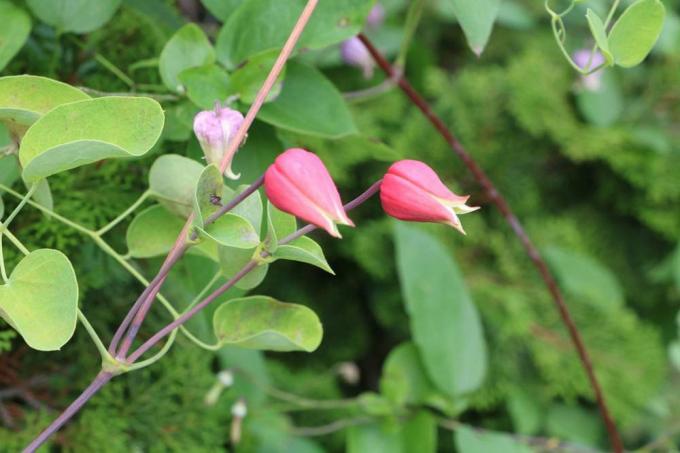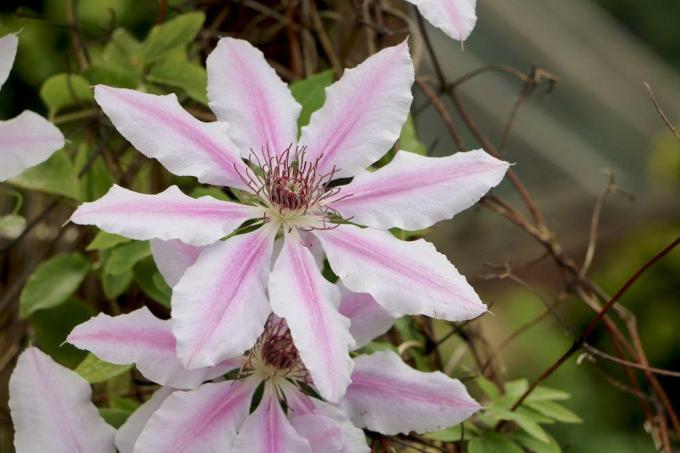
table of contents
- Symptoms
- causes
- Water supply
- fertilization
- Diseases
- Phoma wilt
- Fusarium wilt
the Clematis is a beautiful climber that produces many large flowers in spring and summer. In the trade there are clematis plants with double and unfilled flowers, large-flowered hybrid varieties and wild species such as the Alpine clematis. The plants are very easy to care for and reliably bloom every year. However, it can happen that suddenly yellow or brown leaves appear on the plants. This can be due to harmless care mistakes or a dangerous fungal disease.
Symptoms
If the first problems appear on the plant or even on several clematis, a closer examination should take place. The following symptoms can appear together and each mark a cause:
- drooping leaves that are yellow or brown, very dry or wet soil
- yellowish, pale, drooping leaves, poor growth, possibly green leaf veins
- light brown spots with a yellow halo in early summer, especially on older leaves
- all leaves of a shoot suddenly turn brown and wither from the edge
causes
Before the gardener is very worried about his plants, he should first check the state of care. Especially when suddenly the entire plant looks poor, the leaves droop sadly and turn yellow, a can Care errors be the cause.
Water supply
The soil in the root area is checked for dryness or wetness. Both a too dry location and waterlogging prevent the roots from transferring water and nutrients to the green parts of the plant. The plant dries up. If the location is too dry, vigorous watering is the most important measure. After that, the root area should be shaded. Mulch can be used for this or the area can be planted with low plants. Clematis like it shady in the root area.
is Waterlogging one possible cause, the plant is being dug up. All rotten roots are removed and the clematis gets a new location with appropriate drainage to protect against too much moisture.

fertilization
If the clematis remains in growth, the leaves take on a slightly yellowish color and may even show green leaf veins, a lack of nutrients may be the cause. This can be a single nutrient or several. A soil sample provides information about which nutrient is missing. If you don't want to wait so long for the laboratory to examine the soil sample, adding complete fertilizer to the plant can help. Compost soil with a little rock flour also provides the clematis with new nutrients.
Diseases
If care errors can be ruled out, it could possibly be one of the dreaded clematis diseases. These include the Phoma wilt and the FusariumClematis wilt. The cause of both diseases are fungi that spread in the plant and cause the above-ground shoots to die off.
Phoma wilt
This is the most common form of wilt on clematis. The fungus Ascochyta clematidina penetrates the plants through the older foliage. At the beginning of summer, light brown spots with a yellow halo appear on the leaves. These get bigger and darker until the entire leaf dies.
The fungus also spreads to the woody parts of the plant, infecting petioles, flower stems and new shoots. The entire clematis is infected within a very short time. The fungus spreads rapidly, especially in warm, humid weather and also affects neighboring clematis.
Combat
In the early stages, it can be helpful to liberally remove the infected shoots. All of the cut material should be in Household garbage be disposed of, but must be removed from the garden in any case. Then the plant is treated with an anti-fungal agent. If the inside of the shoots is already infected, this no longer helps. The plant can still die. If the clematis is infected over a large area, only a complete pruning close to the ground will help.
prevention
General prevention against diseases and pests:
- correct choice of location
- Watering and fertilizing as needed
- regular visual inspection for leaf spots
- professional cut with disinfected tools
- Winter and rain protection
You should check the clematis plant regularly from around May. The first spots appear on the underside of the oldest leaves in the lower part of the clematis. Conspicuous shoots are disposed of immediately. Old leaves from the previous year should also be removed from the plant area.
One is also helpful if possible drierLocation, either protected from rain by a canopy or with enough air movement that wet leaves dry off quickly. Varieties that are particularly fond of the fungus should be planted deep enough that the first cm of the shoots are covered with soil. The fungus then does not penetrate as deeply and the plant sprouts again.
Particularly susceptible varieties
In the case of large-flowered hybrids, the entire above-ground part of the clematis can die off. The early bloomers among the clematis are also susceptible. The disease can break out in other species, but does not get beyond individual, small leaf spots. The original varieties with small flowers have proven to be more resistant.

Fusarium wilt
The fungus Coniothyrium clematidis-rectae is responsible for this form of clematis wilt. This disease is rarer than Phoma wilt, but more dangerous because it initially unnoticed runs. The fungus penetrates the plant through injuries on the wooden shoots and clogs the ducts there. The shoots then die off completely within a very short time. The fungus spreads further in the plant and wilts one shoot after the other.
There are no stains on the foliage in advance, so the shoots begin to die off suddenly. The symptoms only begin when the temperatures are particularly high, which the fungus needs to grow.
Combat
To save at least the plant, there is only one more thing to do complete cut backthat should be done close to the ground. Fungicides from specialist gardeners are of no use against the fungus as it is located within the shoots. With a little luck, however, the clematis will sprout again next year.
prevention
Above all, planting strong-growing, healthy varieties and a good supply of nutrients help against Fusarium wilt. Careful handling of the clematis protects against damage to the wood. You should only use disinfected tools for cutting. Winter protection prevents stress cracks caused by excessive sunlight.




